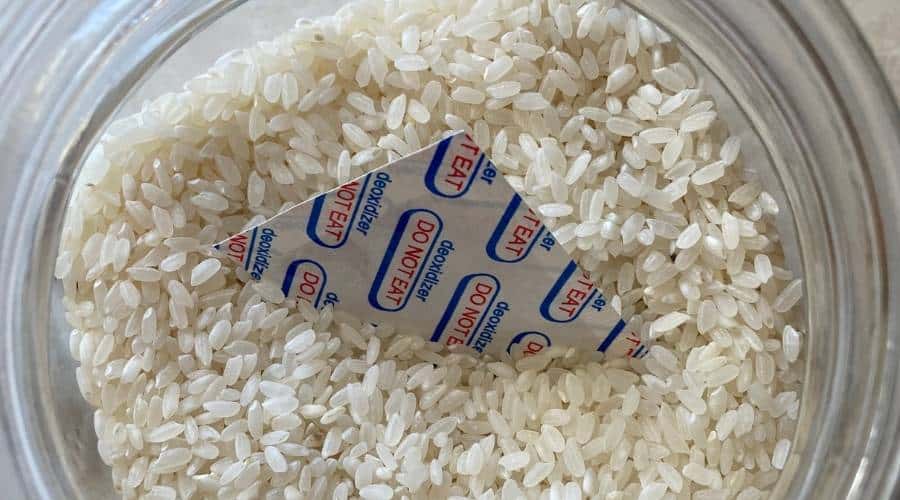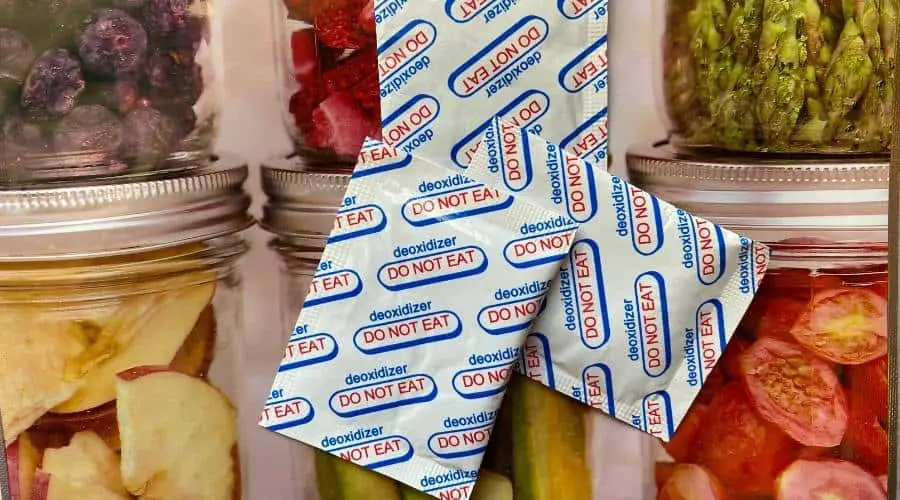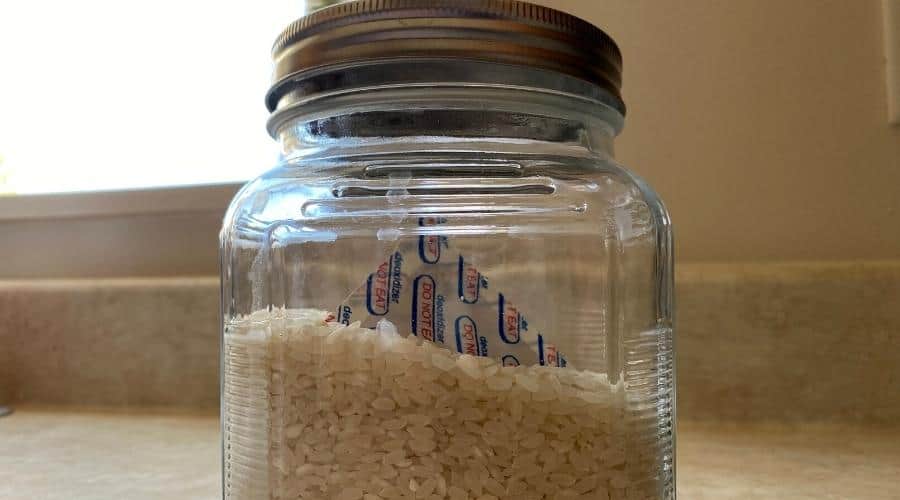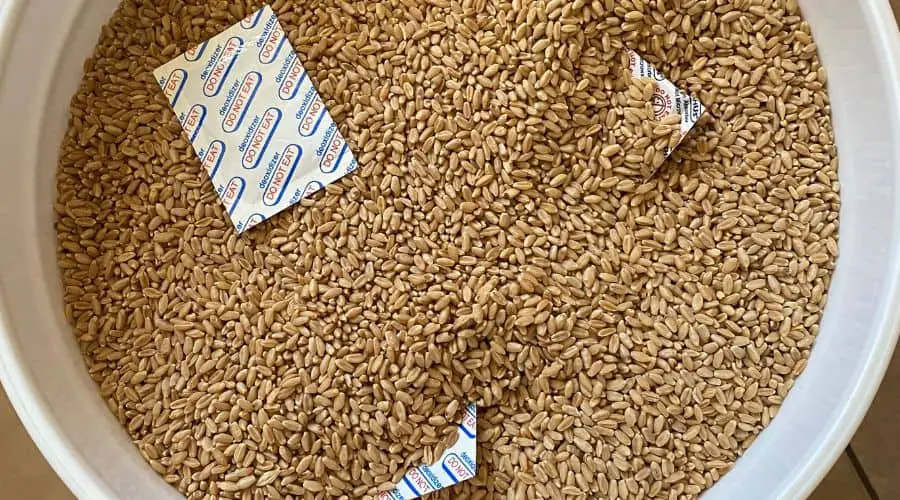Dry foods are an essential and large percentage of my overall food storage because they are easy to store and typically last a long time in storage. However, I quickly learned through experience that one of the factors that affect food storage life is oxygen. So to help extend the life of my dry food storage I had to learn how to use oxygen absorbers with the right dry foods and in the correct way.
On This Page
- What is an Oxygen Absorber?
- How to Use Oxygen Absorbers With Food Storage
- What Size of an Oxygen Absorber do I Need?
- Oxygen Absorber for Food Storage Size Chart
- Best Oxygen Absorbers by Size
- What Foods Can be Stored with Oxygen Absorbers?
- What Foods Should Not be Stored with Oxygen Absorbers?
- What Containers Should be Used with Oxygen Absorbers?
- The Shelf Life of Foods Being Stored with Oxygen Absorbers
- Do Oxygen Absorbers Expire?
What is an Oxygen Absorber?
An Oxygen absorber is a small packet of iron powder and salt used to prolong food’s shelf life. Oxygen absorbers ultimately reduce the presence of oxygen in a food container creating a higher concentration of nitrogen, which is a better environment for extending the shelf life of dry food storage.
“An oxygen absorber works as the available moisture in the food and air causes the iron in the absorber to turn to rust, which then reduces the presence of oxygen, called oxidation. This transition in oxygen content creates a higher concentration of nitrogen, which is better for long-term shelf life. These packets absorb oxygen and effectively reduce the aerobic environment to 0.01% oxygen.”
Food preservation specialist Carolyn Washburn
Advantages of using oxygen absorbers in your food storage:
- Extends the shelf life of food storage
- Prevents oxidation
- Prevents food damage from an infestation of insects
- Inhibits the growth of aerobic pathogens such as molds, mildew, and bacteria
- Significantly improves keeping qualities of polyunsaturated fats and oils
- Delays the discoloration in foods
- Eliminates the need for additives such as sulfur dioxide, BHA, BHT, sorbates, etc.
- Foods are not crushed or squeezed
- Prevent oxidation of vitamins A, C, and E
- Easy to use
How to Use Oxygen Absorbers With Food Storage
Oxygen absorbers are very easy to use and won’t harm your food. All you’ll need is to choose a food that is low in moisture and oil, a container with an airtight seal, and the appropriate size of oxygen absorber.
What You’ll Need
- Dry Food (see list of foods that can be stored with oxygen absorbers)
- Airtight Container (Mylar bag, Mason Jar, # 10 Can, Sealable Food Storage Bucket, PETE Plastic Bottles)
- Oxygen Absorbers (see what size and best absorbers)
- Heat sealer or hot iron to seal Mylar bags (if Mylar bags are used)
Follow the step-by-step guide below when using oxygen absorbers in your food storage.
1. Decide what container to use
A few container options to choose from include:
- Mylar Bags
- Mason Jars
- # 10 Cans
- PETE Plastic Bottles
- Sealable Food Storage Buckets
We usually use mylar bags because they are easy to store and work well, however, glass mason jars or # 10 cans work better if you want to prevent your food from getting crushed.
2. Determine what size of oxygen absorbers to use
Typically oxygen absorbers come in sizes ranging from 50cc to 2500cc. Here is a simple quick reference chart that will work (see a comprehensive chart down the page).
| Container Size | Oxygen Absorber Size in cc (cubic centimeters) |
|---|---|
| 1/2 PINT (237ml) | 50cc |
| PINT (473ml) | 100cc |
| QUART (946ml) | 300cc |
| GALLON (3.8L) | 500cc |
| 5 GALLONS (18.9L) | 2500cc |
It is better to use an oxygen absorber that is higher in cc than one that is not enough.
3. Prepare your food and fill the container
Make sure your food is fresh and free of any debris (common with beans). Then add it to your choice of containers, but do not put the lid on or seal the bag yet.
Also, make sure you fill the container so there is minimal air left in the container.
4. Promptly place the oxygen absorber in with food and seal the container
Place the oxygen absorber in the bag right along with the dry food and quickly seal the container. It is best to be quick when placing oxygen absorbers. Don’t leave them out for a long period of time.

How do you activate an oxygen absorber?
Oxygen absorbers are activated automatically when they encounter oxygen. All that is required is that absorbers are pulled out individually and placed in a food container.
How quickly do you need to use oxygen absorbers?
Oxygen absorbers will begin absorbing oxygen immediately so you’ll want to get them sealed in the storage container within 10 minutes of opening. Also, don’t forget to reseal the bag or jar that you’re using to store your oxygen absorbers that aren’t yet in use.
Oxygen absorbers should feel like they have something soft and powdery inside. If you have one that feels hard or chunky, throw it away because it is likely depleted and won’t absorb any more oxygen.
Make sure to reseal the remaining absorbers so they don’t oxidize and become useless.
How long does it take the oxygen absorber to work?
Once sealed in an airtight container the oxygen absorber will work (meaning absorb the oxygen) within 4-6 hours. We typically check the container or bag for a tight seal about 24 hours after sealing before storing long-term.
Why does the oxygen absorber feel warm?
Oxygen absorbers will heat up as they start to absorb oxygen. So if you are handling one that is warm, that is a good sign it is working. Just seal it up quickly. If it gets hot, I will toss it.
Can oxygen absorbers touch food?
Oxygen absorbers can be placed right in a container touching the food without hurting or contaminating the food. Oxygen absorbers are mini sachets containing iron fillings, clay, and salt so they are safe.
How do I know if my oxygen absorber is working?
The easiest way to tell if an oxygen absorber is working is to feel or pinch the packet. If it feels soft and powdery it will continue to work. If it feels hard or like there is a solid wafer in the packet, it is all used up and should be discarded.
Why do some of the Mylar bags not look like the oxygen absorbers are working?
According to climate.nasa.gov air is made up of 21 percent oxygen and 78 percent nitrogen. Nitrogen takes up space just like oxygen. Oxygen absorbers only remove the oxygen, not the nitrogen so mylar bags will likely shrink some but not as much as a vacuum-sealed bag.
If you are concerned about whether your Mylar bags are appropriately sealed and your oxygen absorbers are working, here is a checklist to consider.
- Is the Mylar bag of good quality without any pinholes that allow air to escape? Test for air leaks by gently squeezing the bag and listening/feeling for any escaping air.
- Is the Mylar bag seal secure? Mylar bags should be heat sealed and Mylar zip locks are for convenience after opening but will not maintain an oxygen-free environment.
- Are the oxygen absorbers fresh, new, soft, or pliable? If not then discard.
- Is the correct size oxygen absorber for the container being used? Using an oversizing oxygen absorber is not a problem because the reaction will stop when all the oxygen is removed. However, an oxygen absorber that is too small for the container will be exhausted before all the oxygen is removed. We like to oversize the required oxygen absorber for the container just to be sure.
If you are concerned that the Mylar bag or pouch has not been properly sealed, simply cut a slit in the top of the bag and add a fresh oxygen absorber and reseal it with heat.
What Size of an Oxygen Absorber do I Need? Full Chart
Typically oxygen absorbers come in sizes ranging from 50cc to 3000cc. Cubic centimeters (cc) refer to the amount of oxygen-absorbing capacity each individual packet has.
When deciding what size of absorber to use we consider that some dry goods such as wheat, rice, rolled oats, and flour takes up more space in the container, therefore, leaving a lower volume of oxygen that needs to be removed. Pasta, dry beans, and pet food will leave space for more air in the container and will require a larger oxygen absorber.
Oxygen absorbers won’t hurt or contaminate food so it is safe to add one that is a little bigger than what you need. I always round up if I am uncertain. However, if you use an absorber that is just a little bit too small, then it won’t remove enough oxygen and could result in oxygen remaining in the container allowing oxidation to occur and the growth of insects.
I prefer to keep things in smaller containers like mylar bags, jars, and other containers that are typically a gallon or less in size. That way they are a good size to use and I’m not digging into a larger storage container often and risking contaminating a larger amount of food.
I usually purchase 400cc or 500cc oxygen absorbers and use them for everything one gallon or smaller. If I’m sealing something in a large bucket I just use 3 to 5 of them depending on the circumstances.
Oxygen Absorber for Food Storage Size Chart (cc)
| Container Size (Fill completely) | Flour, Grains, Wheat, Oats, Rice, Powders (Lower oxygen volume in container) | Dried Pasta, Cereal, Barely, Dried Corn, Beans, Coffee Beans (Higher oxygen volume in container) |
|---|---|---|
| 1 Pint (16 oz.) | 50cc | 100cc |
| 1 Quart (32 oz.) | 100cc | 150cc |
| 1/2 Gallon (64 oz.) | 200cc | 300cc |
| #10 Can (0.82 gallons) | 350cc | 500cc |
| 1 Gallon | 400cc | 500cc |
| 1 1/2 Gallon | 600cc | 800cc |
| 2 Gallon | 800cc | 1000cc |
| 4.25 Gallon | 1700cc | 2000cc |
| 5 Gallon | 2000cc | 2500cc |
| 6 Gallon | 2300cc | 3000cc |
Pack food tightly and fill containers completely to insure adequate absorption. If you are not certain which column your product should be in, use the greater quantity. There is nothing wrong with using more absorption than required.
How many Oxygen absorbers should I use?
Use as many oxygen absorbers as it takes to reach the correct level of cubic centimeters (cc). For example, in a one-gallon container of Wheat, you should use one oxygen absorber with 400cc. However, you could also use two 200cc absorbers instead.
Often it will only take one absorber to reach the correct amount depending on the size of the container and the amount of oxygen in the container. See the above chart as a reference.
Best Oxygen Absorbers by Size
What Foods Can be Stored with Oxygen Absorbers?
Dry foods that are low in moisture (10% or less) and low in oil are the best foods to store with an oxygen absorber.
Many dry and low-fat foods can be stored with oxygen absorbers. This includes foods like:
- Wheat Berries
- Flour
- Whole Grains
- Rolled Oats
- Pasta
- Dried Beans
- Dried Potato Flakes
- White Rice
- Powdered Milk
- Cereal
- Dried Corn
- Barely
- Coffee Beans
- Freeze-dried Foods
- Dehydrated Foods that are dry enough to snap when bent
- Dried Onions
- Dried Carrots
- Spices
Some foods like whole grains, peas, and beans aren’t overly oxygen-sensitive. If you plan on using these types of foods within 5 years, there won’t make a big difference in freshness regardless of whether you use oxygen absorbers or not.
However, oxygen absorbers do protect against pests and have other benefits like preserving nutrition. Since oxygen absorbers are cheap, we recommend using them with the above list of dry foods that you want to store for 12 months or longer.
As an example, see how to store pomegranates long-term including dehydrating and freeze-drying them and including oxygen absorbers.
Dehydrated fruits, vegetables, and other foods with Oxygen Absorbers
To safely store dehydrated food with oxygen absorbers, it must be dry enough that it snaps when bent. Or for foods that are more round like corn or peas, it should shatter when pressed with something hard.
Warning: Botulism poisoning may result from packaging foods with high moisture content in reduced oxygen packaging. Just because someone else does it doesn’t mean that it is a safe practice.
Nuts and Seeds with Oxygen Absorbers
Storing nuts and seeds with oxygen absorbers will extend their shelf life. However, they will eventually become rancid because they contain so much oil.
Most people put the shelf life of nuts/seeds with OAs at about 2 years. However, nuts and seeds can last longer than this, even when exposed to oxygen. The key is keeping the temperature and humidity low.
How do I find the moisture content of dry goods?
Moisture levels in dry foods can vary. To determine the moisture level of a specific food simply contact the manufacturer or visit the US Department of Agriculture Agricultural Research Service Website.
Should you use oxygen absorbers in flour?
You should use oxygen absorbers with flour in an airtight container (#10 can, Mylar bag, mason jar, or PETE plastic bottle) to achieve the longest shelf life possible.

What Foods Should NOT be Stored with Oxygen Absorbers?
There are a few varied opinions on what dry foods should be stored with oxygen absorbers. The Church of Jesus Christ of Latter Day Saints is one of the main authorities on food storage because they have been successfully leading the niche for the longest time. The below list are foods that they suggest not storing with oxygen absorbers.
A list of foods that should NOT be stored with oxygen absorbers include:
- Brown Rice
- Jerky
- Granola
- Pearled Barley
- Dried Eggs
- Milled Grains (other than rolled oats)
- Brown Sugar
- Any Dehydrated fruit or vegetables not dry enough to snap when bent
- Nuts
- Baking Powder and Baking Soda
- White Suger
- Salts
- Wet foods: Foods with 35% or more moisture can grow botulism in airless environments. It is recommended that foods stored with oxygen absorbers should have a 10% or less moisture level.
Does sugar or salt need oxygen absorbers?
Neither sugar nor salt needs oxygen absorbers because it will cause sugar to turn into a solid brick and salt to clump together. Sugar and salt are much better stored without the use of oxygen absorbers.
What Containers Should be Used with Oxygen Absorbers?
The best containers to use with oxygen absorbers are non-permeable that have an airtight seal. Containers that will achieve the longest shelf life are made from materials such as metal, glass, Mylar, or PET/PETE plastic.
You can use one of the following types of containers with an oxygen absorber.
- Foil pouches (called Mylar Bags)
- Metal cans with seamed lids (called #10 cans)
- Glass Mason Jars
- PETE Plastic Bottle
- Food-grade plastic buckets (typically 5-6 gallons) with mylar bags

Containers NOT to use with Absorbers
Oxygen Absorbers do not work in Ziploc plastic bags because they won’t be able to completely form an airtight seal. Also, don’t use non-PETE plastic containers without a mylar bag.
The Shelf Life of Foods Being Stored with Oxygen Absorbers
It is important to know the shelf life of different dry foods that are stored in airtight containers with oxygen absorbers. See a list of food items below and their associated shelf life.
| Food Type | Shelf-Life |
|---|---|
| Hard Whole Grains | 10+ years |
| Soft Whole Grains | 8+ years |
| Professionally-Dehydrated Fruits and Vegetables (only use absorbers if dry enough to break when bent) | 10-20 years |
| Home-Dehydrated Fruits and Veggies (only use absorbers if dry enough to break when bent) | 2-5 years |
| Freeze-Dried Fruits and Vegetables | 25 years |
| Dry Legumes (Beans, lentils, chickpeas, split peas) | 25+ years |
| White Rice | 10-30 years |
| White Flour | 10-15 years |
| Whole-Wheat Flour | 10 years |
| Corn Meal | 5-10 years |
| Potato Flakes | 30 years |
| Dry Pasta | 20-30 years |
| Dry Non-Fat Milk | 15 years |
| Nuts | 1-5 years |
See the following foods for a more detailed breakdown of their individual shelf life.
Do Oxygen Absorbers Expire?
Unused oxygen absorbers will expire after 6 months of being stored in an airtight glass jar or PETE container. Absorbers that are currently being used in a container with food will last from 6 months to a year before being opened and used.
How long do oxygen absorbers last once opened?
If opened and exposed to the air an oxygen absorber’s life is very short and will only last for 15 to 20 minutes before exhausting its usefulness.
How to tell if oxygen absorbers are still good or expired (bad)?

An exhausted (or bad) oxygen absorber will turn spotty, brown, and hard or clumpy. Bad or expired oxygen absorbers won’t hurt your food however, they will no longer absorb oxygen and become useless.
An oxygen absorber that is still good will be soft, and the powder will be pink or gray.
Some oxygen absorbers come with a color indicator on the individual packet that changes when they expire. The color indicator will vary from pink to a reddish hue if the packet is unused. Once that indicator has been exposed to air it will turn blue or purple. The indicator does not mean that the absorbers are bad. Simply, the indicator has been exposed to oxygen.






